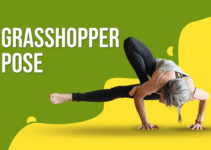- Hatha Surya Namaskar
- Sivananda Sun Salutation
- Ashtanga Surya Namaskar
- Surya Namaskar A
- Surya Namaskar B
- Iyengar Surya Namaskar

Surya Namaskar (Sun Salutation) is the most practiced sequence of 12 poses in yoga. However, the original sequence comprises a predictable progression of poses but there are enormous variations of its execution from one style of yoga to another. There are 4 types of Surya Namaskar that are practiced in popular styles of yoga;
- Hatha Surya Namaskar
- Sivananda Sun Salutation
- Ashtanga Surya Namaskar
- Surya Namaskar A
- Surya Namaskar B
- Iyengar Surya Namaskar
No matter how it is practiced, sun salutation benefits the body & mind in all types. It increases internal heat in the body, warms up muscles, improves blood circulation, and calms the mind.
1. Hatha Surya Namaskar

In hatha yoga, Ha & tha is called to the Sun & Moon. To pray for the Sun, 24 poses are performed in Hatha Surya Namaskar in one set of practices. One set comprises 12 poses in the first round and 12 repeated poses (except leg change in steps 4 & 9) in the second round.
Surya Namaskar described in Hatha Yoga is the traditional and the most ancient form. It’s performed at a slow pace with long stays in each posture; so it’s considered an easy approach for a student who finds sun salutation uncomfortable as a fast-flowing series.
12 poses of Hatha Surya Namaskar are;
- Prayer pose
- Raised arms pose
- Standing forward bend
- Equestrian pose
- Mountain Pose
- Eight limbed pose
- Cobra pose
- Mountain Pose (Parvatasana)
- Equestrian pose
- Standing forward bend
- Raised arms pose
- Prayer pose
All these poses work on improving the strength and flexibility of the body. It also balances basic constituents of the body, i.e. Vata, Pitta, and Kapha, and balances all the five elements of the body. Due to these, it is beneficial and remedial to cure several ailments and tones the body internally as well as externally.
2. Sivananda Sun Salutation
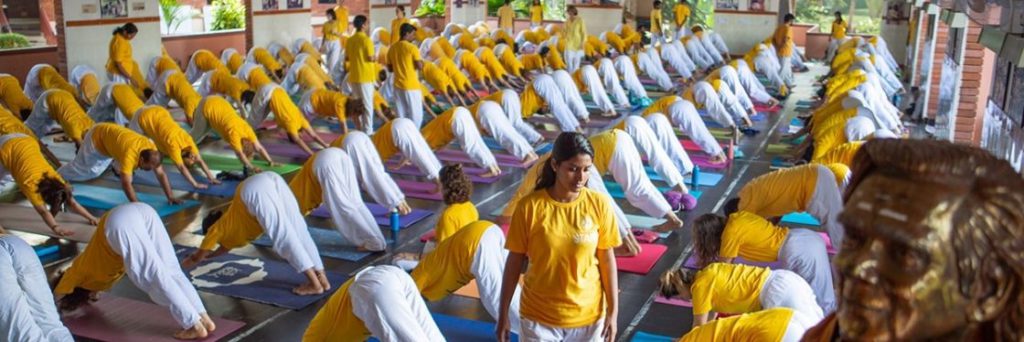
Sivananda style sun salutation is similar to traditional Hatha sun salutation. Here twelve basic positions performed as one continuous exercise making a series of prostrations to the sun.
In comparison to other styles of sun salutation, here the pace of flow from one pose to another is kept medium. It makes the Sivananda sun salutation suitable for beginners. The purpose of it is to warm up the body in preparation for longer asana practice.
Sun salutation of Sivananda style is known as the basic sun salutation sequence. It’s taught by Swami Vishnudevananda, a disciple of Sivananda Saraswati. Today, in a Sivananda yoga class, Sun Salutation is followed by Pranayama or breathing exercises. Then after Sun Salutation, a sequence of 12 basic asanas of hatha yoga comes.
3. Ashtanga Surya Namaskar
Ashtanga Surya Namaskar is entirely different from traditional Surya Namaskar in terms of sequence, poses, and pace. It’s comparably fast-paced and does more emphasis on synchronizing breathing with the physical movement from one pose to the next; called Vinyasa.
This sequence of sun salutation is widely practiced in Ashtanga Vinyasa yoga. Here sun salutation is not practiced into one sequence rather divided into 2 parts which specifically are known as;
- Surya Namaskar A
- Surya Namaskar B
Surya Namaskar A
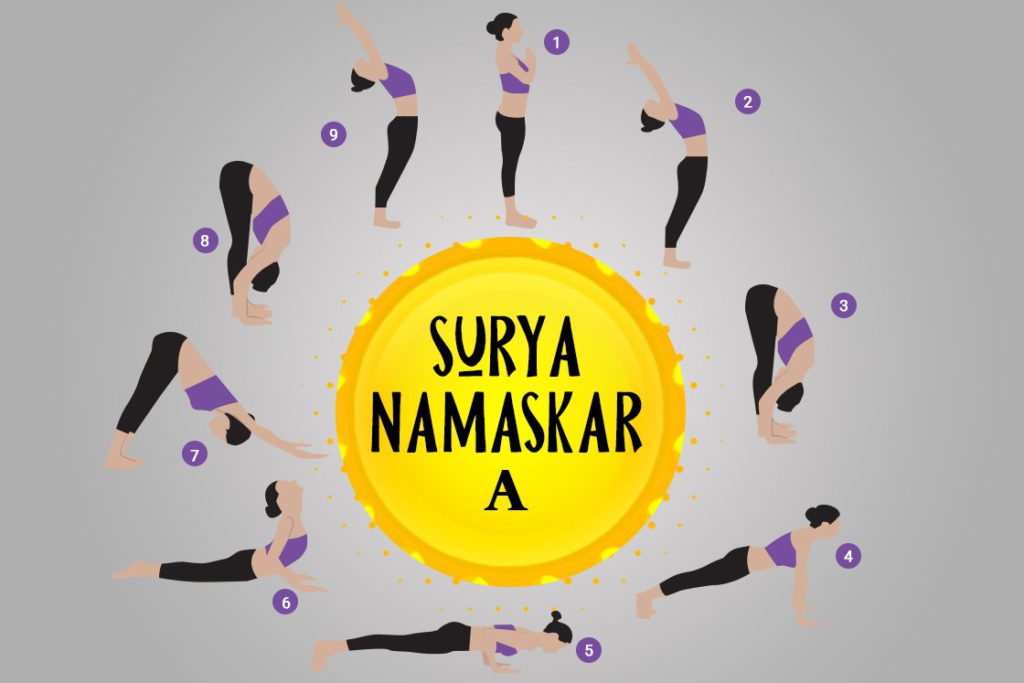
It’s the first sequence of Ashtanga Surya Namaskar comprises 10 poses. Before beginning all Ashtanga Vinyasa series, 5 rounds of this sequence is considered sufficient to induce heat and stamina in the body. However, traditionally in Ashtanga yoga, 5 rounds of A sequence is followed by 5 rounds of B.
10 poses of Surya Namaskar A sequence are;
- Samasthiti (Tadasana)
- Urdhva Hastasana (Raised Hands Pose)
- Standing Forward Bend (Uttanasana)
- Half Standing Forward Bend (Ardha Uttanasana)
- Four-Limbed Staff Pose (Chaturanga Dandasana)
- Upward Facing Dog (Urdhva Mukha Svanasana)
- Downward Facing Dog (Adho Mukha Svanasana)
- Standing Forward Bend (Uttanasana)
- Raised Hands Pose (Urdhva Hastasana)
- Samasthiti (Tadasana)
You can learn here how to do Surya Namaskar A sequence.
Surya Namaskar B
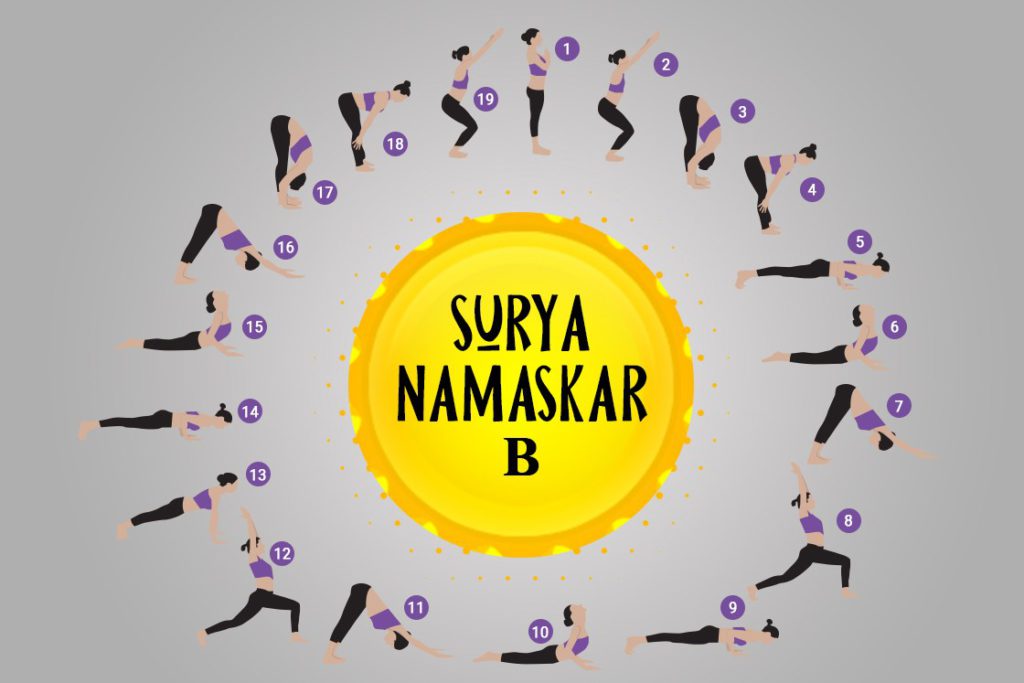
This sun salutation sequence is little intensified flow compare to the prior one. Like any other Ashtanga Vinyasa sequence, here each breath is accompanied by a movement in consecutive poses. B Surya Namaskar always is followed by the ‘A’ sequence before any Ashtanga Vinyasa class.
There are 19 poses in Surya Namaskar B sequence;
- Samasthiti (Tadasana)
- Chair Pose (Utkatasana)
- Standing Forward Bend (Uttanasana)
- Half Forward Bend (Ardha Uttanasana)
- Four Limbed Staff Pose (Chaturanga Dandasana)
- Upward Facing Dog (Urdhva Mukha Svanasana)
- Downward Facing Dog (Adho Mukha Svanasana)
- Warrior I (Virabhadrasana I)
- Four Limbed Staff Pose (Chaturanga Dandasana)
- Upward Facing Dog (Urdhva Mukha Svanasana)
- Downward Facing Dog (Adho Mukha Svanasana)
- Warrior I (Virabhadrasana I)
- Four Limbed Staff Pose (Chaturanga Dandasana)
- Upward Facing Dog (Urdhva Mukha Svanasana)
- Downward Facing Dog (Adho Mukha Svanasana)
- Half Forward Bend (Ardha Uttanasana)
- Standing Forward Bend (Uttanasana)
- Chair Pose (Utkatasana)
- Mountain Pose (Samasthiti or Tadasana)
As you will notice, a flow of four-limbed pose → upward dog → downward dog → warrior I repeated 3 times in the sequence. This is strength building vinyasa flow which is the heart of the Surya Namaskar B sequence.
You can learn here how to do Surya Namaskar B sequence.
For a beginner, Ashtanga Surya Namaskar can be daunting, as in this -one has to flow in between poses quickly with the rapid transition and synchronized breathing. But it’s very great to build stamina and detoxify the body.
4. Iyengar Surya Namaskar
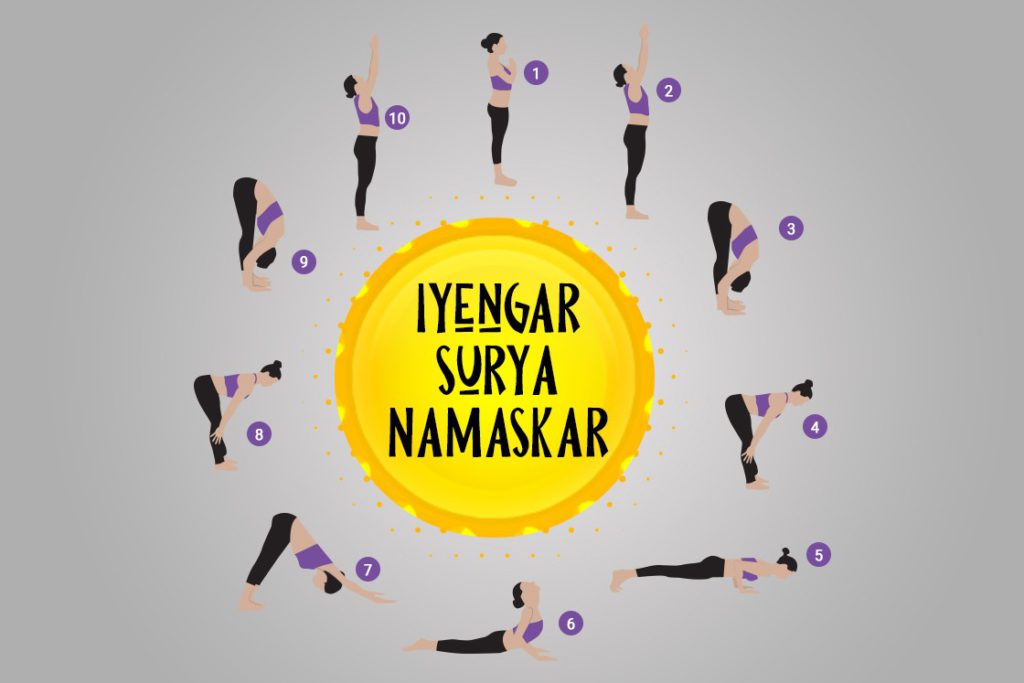
Iyenger’s way of Surya Namaskar is a swiftly transitioning flow of postures and shares similarity with the Hatha Surya namaskar. It also includes 12 yoga poses but here you can personalize the flow using some props and play around with traditional poses. However, In most of the Iyengar classes, the sequence of Surya Namaskar poses remain like this:
- Tadasana (Mountain Pose)
- Urdhva Hastasana (Upward Hand Pose)
- Uttanasana (Standing Forward Bend)
- Ardha Uttanasana (Half Standing Forward Bend) *
- Uttitha Chaturanga Dandasana (High Plank Pose) *
- Chaturanga Dandasana (Four-Limbed Staff Pose) *
- Urdhva Mukha Svanasana (Upward-Facing Dog) *
- Adho Mukha Svanasana (Downward-Facing Dog Pose) *
- Ardha Uttanasana (Half Standing Forward Bend) *
- Uttanasana (Standing Forward Bend)
- Urdhva Hastasana (Upward Hand Pose)
- Tadasana (Mountain Pose)
* poses are new poses in Iyengar style replaced by different alternative poses. The late B.K.S Iyengar who is the founder of Iyengar yoga didn’t mention creating this sun salutation sequence. Although it’s widely adopted in the power yoga session.
The pace of Iyengar’s Sun Salutation is somewhat between Hatha style and Ashtanga style. As Iyengar yoga style is uniquely known for its alignment and precision in poses, sun salutation here is a little more intense. But adding props into poses gives one variety of choices to modify the poses. It works on strengthening the upper body and cardiovascular endurance.
Conclusion
In different schools of yoga, the sequence and poses of surya namaskar are slightly different. It has made different types of Surya namaskar, however, all variations of it are derived from the traditional one.
For a beginner, it’s recommended to start with traditional surya namaskar of hatha yoga. It’s so because here one can find a stability in flow of poses and can be remain in each posture for 4 to 5 breath. However, advanced practitioner prefer fast-paced Ashtanga surya namaskar.
